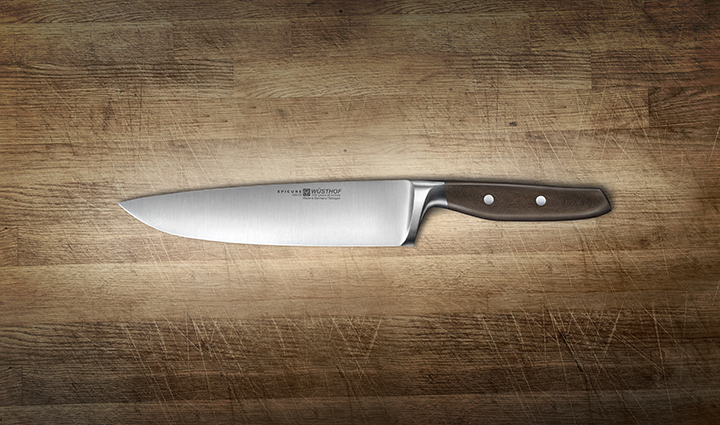Know your tang from your bolster with this handy guide to understanding the anatomy of a knife.
Knowing which knife to choose for a particular job, starts with understanding the anatomy of the knife. Knowing the elements that make up a knife will also inform how you hold it, make your life in the kitchen easier and hopefully help you avoid accidents.
The Chef’s Knife
The Chef’s Knife (sometimes known as a Cook’s Knife) is the foundational knife for any kitchen, offering a mix of heft, sharpness and precision slicing ability. The Chef’s Knife is usually available in 16cm, 18cm and 20cm versions to allow cooks to select the blade they feel most comfortable with and the job at hand.
Though it initially appears that a knife is made of two parts – the blade and the handle – it’s worth looking a little more closely to discover the important elements that separate a basic knife from a high-quality precision instrument.
The blade
The blade is obviously an important part of the knife, providing the slicing edge. As an example, Wüsthof knife blades are forged from a single piece of steel – chromium-molybdenum-vanadium steel, to be exact – which makes them easy to sharpen and maintain, as well as long-lasting. Many metals can be used to create blades, but high-carbon stainless steel combines the sharpness of carbon steel with the durability and strength of stainless steel. The best-quality blades are also taper-ground, meaning that the blade is forged from a single sheet of metal, tapering from the spine to the cutting edge, without any sign of beveling.
The front point of the blade is known as the tip. Maintaining the tip is important as it guides the path of the rest of the blade to help create smooth slices. The sharp slicing face of the blade is known as the edge. There are different types of edges for different applications: the straight edge of a Chef’s Knife is designed to offer a smooth, clean, exact cut – no matter whether you’re slicing meat, vegetables or fruits. Knives with serrated edges, are best used for cutting through foods with a hard exterior and soft interior – like a loaf of crusty bread. The scalloped teeth on the blade catch the surface and then rip, helping slice smoothly through the harder exteriors. Storing knives in a knife block or on a knife magnet helps maintain the integrity of the entire blade, ensuring many happy years of use.
The top part of the blade is called the spine – thicker than the slicing edge and, when ground properly as it should be on a high-quality knife, beautifully smooth. Equally important is the bolster, which is the thicker section between the blade and the handle of the knife. Both spine and bolster play an important role when holding the knife in the Pinch Grip, which many professional chefs swear by for maximum control when slicing and chopping.
The presence of a bolster also points to the fact that the knife is forged – one of the potential signs of a good quality instrument. The additional weight provided by the bolster improves the balance of the knife and helps ensure a safe fit in the hand. Some knives feature a double bolster for additional ease and control. Just beneath the bolster, at the ‘back’ of the blade (under the bolster) is the heel of the knife, which is shaped and unsharpened so that the knife can be handled safely.
Inside the handle
Inside the handle – and an extension of the blade, beyond the bolster – is the tang. Knives used for heavy work, such as Chef’s knives or cleavers, should have a full tang, where the tang is almost as long as the entire handle. The handle is normally attached to the blade by riveting it to the tang – except on some knives which feature a forged stainless steel handle that becomes one with the blade. Handles can also be made of plastic or wood and well-made knives feature multiple stainless steel rivets to ensure the handle stays firmly connected to the blade – and also for hygiene purposes, to ensure that no stray food can get stuck between the blade and the handle. Finding the right handle for maximum comfort and control – whether determined by material or shape – is important. Wüsthof knives feature a variety of handles from plastic (Colours, Silverpoint, Gourmet, Grand Prix, Pro, Classic and Classic Ikon), to stainless steel (Culinar), natural fibre and resin combination (Epicure) and African Blackwood (Ikon) handles, in a variety of shapes, to suit every hand.


